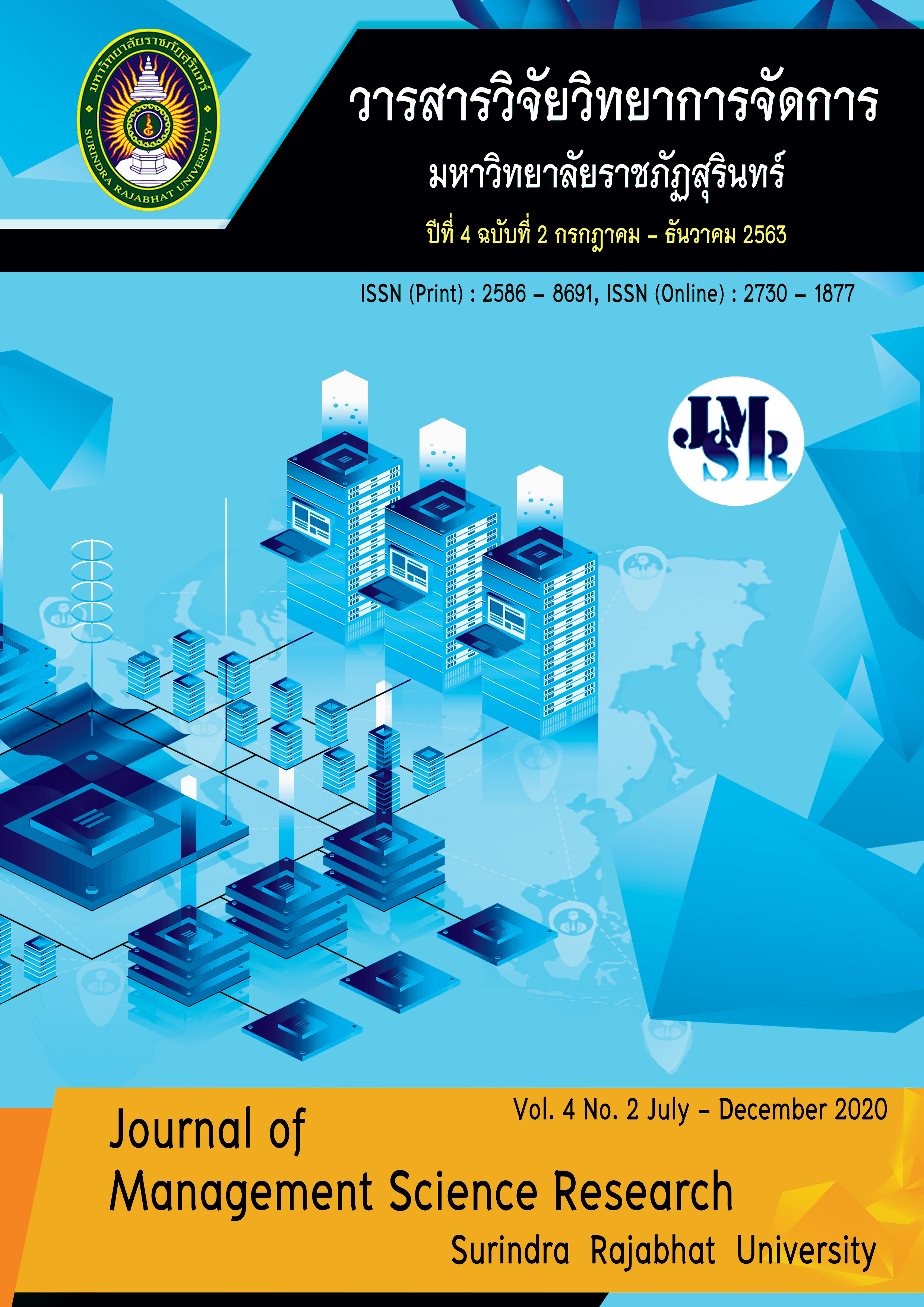Pla Daek (Fermented Fish) : The Multi-Cultural Connection through Its Consumption by the Isan People
Keywords:
Pla-Daek, Multi-Culturalism, Identity, ConnectionAbstract
Pla Daek is considered to be one of the five spirits of the Isan region along with sticky rice, Laab, Papaya Salad, and Mor Lam. Pla Daek (Pla Ra) is an evidence of identity within the multicultural society of the Isan people. The composition of Pla Daek in a jar reveals its association with Isan society, culture, and livelihood as the people relate to the physical conditions of the plateau and the cultures of the fishermen. As a well-known food, Pla Daek has been consumed by the Isan people for a long time and reflects an abundance of rice, fish, food, generosity, harmony, familiarity, and relationships. Each of the preceding has been combined within the culture of Isan fish consumption, which has been passed on to other communities and shows the harmonious connections and the relationship of the culture of consumption. The presentation of this academic paper focuses on the process of linking multiculturalism through the consumption of the Isan people. In the past, Pla-Daek was only produced for household consumption, but now it is produced for commercial purposes. As such, it continues to contribute to a variety of distribution channels in both Thailand and in countries overseas. When migrating to other regions, the Isan people brought their consumption culture with them. In economic terms, it is also a reflection of Pla-daek consumption culture, which has changed over time. In this age of globalization, communication via social media, which is particularly being used a means of connecting with others, is fast and infinitely widespread. In addition, through the stories of influencers and celebrities, the consumption behaviors, which can be found on social media, have become generally recognized. As a result, the consumption of Pla-Daek is not presently facing the social discrimination that it has in the past. As it turns out, Pla-Daek has, in contrast, become a seasoning product, which people can easily access and enjoy. Finally, this access has allowed the culture of Pla-Daek consumption to expand far and wide.
References
คณะเทคโนโลยี มหาวิทยาลัยมหาสารคาม. (2561). เมนูอาหารจากปลาร้า. ขอนแก่น : ศิริภัณฑ์ (2497).
ชญาณ์นันท์ ปิติกรพวงเพชร, พิกุล สายดวง, พรหมมินทร์ กองแก้ว. (2560). การศึกษาความหลากหลายของอาหารหมัก ดอง อาหารพื้นบ้านกับความมั่นคงทางอาหารบริเวณชุมชนริมฝั่งแม่น้ำโขงตอนล่างของประเทศไทย. วารสารมนุษยศาสตรและสังคมศาสตร์ มหาวิทยาลัยราชภัฎอุบลราชธานี, 8(2), 239 – 257.
ญาณภา บุญประกอบ, จักรวาล วงศ์มณี, สิริพร เขตเจนการ, โยธิน แสวงดี. (2560). อาหารพื้นถิ่นกับกลไกในการส่งเสริมการท่องเที่ยวเชิงสร้างสรรค์ : กรณีศึกษากลุ่มชาติพันธุ์ลาวครั่ง จังหวัดชัยนาท. วารสารวิทยาลัยดุสิตธานี. 11(พิเศษ), 93 – 108.
ทวีศักดิ์ แสวงสาย และฤดีมาศ แสวงสาย. (2559). ภูมิปัญญาอาหารชาติพันธุ์เพื่อสุขภาพของชาวไทยเขมร ไทยกูยและไทย ลาว ในเขตอีสานใต้. วารสารวิจัยและพัฒนา มหาวิทยาลัยราชภัฎเลย, 11(พิเศษ), 84 – 91.
ไทยโพสต์. (2561). พาณิชย์เดินหน้าช่วยขาย 'ปลาร้า' เต็มสูบ เตรียมดันขายในสนามบิน [ออนไลน์]. ค้นเมื่อ 18 พฤษภาคม 2563, จาก : https://www.thaipost.net/main/detail/7533.
ไทยรัฐออนไลน์. (2561). ผู้ผลิตขานรับ ยกมาตรฐาน‘ปลาร้าไทย’สู่ตลาดโลก เชื่อทำได้ ไปโลด [ออนไลน์]. ค้นเมื่อ 18 พฤษภาคม 2563, จาก : https://www.thairath.co.th/news/local/northeast/1259354.
ผกาวดี ภู่จันทร์ และโสรัจวรชุม อินเกต. (2559). สำรับอาหารพื้นถิ่นเมืองพิษณุโลก. วารสารกระแสวัฒนธรรม มหาวิทยาลัยราชภัฎพิษณุโลก, 17(32), 3 – 16.
พจมาลย์ พุดมี และสมสุข หินวิมาน. (2559). ชนชั้นกลางกับการสื่อสารรสนิยมในการบริโภคส้มตำ. วารสารนิเทศศาสตร์ มสธ, 6(1), 20 – 35.
ปิยธิดา ทวีค้ำคูณ, พัฒน์นรี ภูนพมาศพงษ์, นภาพร ดีผ่อน, รวิสรา จิตรบาน, พัชรีภรณ์ กรจักร, ศิริญา อินทรประเสริฐ, และคณะ. (2558). สังคมพหุวัฒนธรรมในส้มตำเมืองขอนแก่นแดนอีสาน [ออนไลน์]. ค้นเมื่อ 18 พฤษภาคม 2563, จาก : https://prezi.com/i_ecanr6k-cc/presentation.
ประสงค์สม ปุณยอุปพัทธ์ และสุกฤตา ปุณยอุปพัทธ์. (2560). กระบวนการและจุลินทรีย์ที่เกี่ยวข้องในการผลิตอาหารหมัก. กรุงเทพฯ : โรงพิมพ์แห่งจุฬาลงกรณ์มหาวิทยาลัย.
ศิริพร คําสะอาด, สุพจน์ คําสะอาด, วัชรพงศ์ พุทธิสวัสดิ์. (2561). ความสัมพันธ์ระหว่างการกินปลาร้ากับการเป็นมะเร็งท่อน้ำดีชนิดภายนอกตับ. วารสารวิจัยสาธารณสุขศาสตร์ มหาวิทยาลัยขอนแก่น, 11(2), 10 – 18.
สุปิยา ทาปทา. (2552). ไหวิถีคิดวิถีชีวิตที่เปลี่ยนไป. วารสารวัฒนศิลปสาร, 4(1), 1 – 30.
อัจฉริยา สุริยา และชื่นจิต จันทจรูญพงษ์. (2561). วิธีการผลิตและปัจจัยที่เกี่ยวข้องต่อคุณสมบัติของปลาร้าในพื้นที่ภาคอีสานตอนบน. วารสารวิทยาศาสตร์บรูพา, 23(1), 566 - 578.
SDUChannels. (2561). สังคมพหุวัฒนธรรม clip1[ออนไลน์]. ค้นเมื่อ 18 พฤษภาคม 2563, จาก : https://www.youtube.com/watch?v=d1gimVm9G_A.







